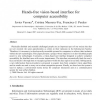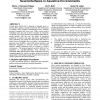16 search results - page 3 / 4 » Designing with children with severe motor impairments |
JNCA
2008
13 years 6 months ago
2008
Physically disabled and mentally challenged people are an important part of our society that has not yet received the same opportunities as others in their inclusion in the Inform...
PETRA
2009
ACM
14 years 14 days ago
2009
ACM
Loosing motor activity due to impaired or damaged nerves or muscles affects millions of people world-wide. The resulting lack of mobility and/or impaired communication bears enorm...
TITB
2010
13 years 20 days ago
2010
Widespread use of affective sensing in healthcare applications has been limited due to several practical factors such as lack of comfortable wearable sensors, lack of wireless stan...
ASSISTIVE
1998
Springer
13 years 10 months ago
1998
Springer
People with severe speech and motor impairments SSMI can often use augmentative communication devices to help them communicate. While these devices can provide speech synthesis or ...
MVA
2007
13 years 7 months ago
2007
We present a system to automatically assess the functional performance of stroke survivors along axes defined by the Arm Motor Ability Test (AMAT). The upper body motion of seven...


